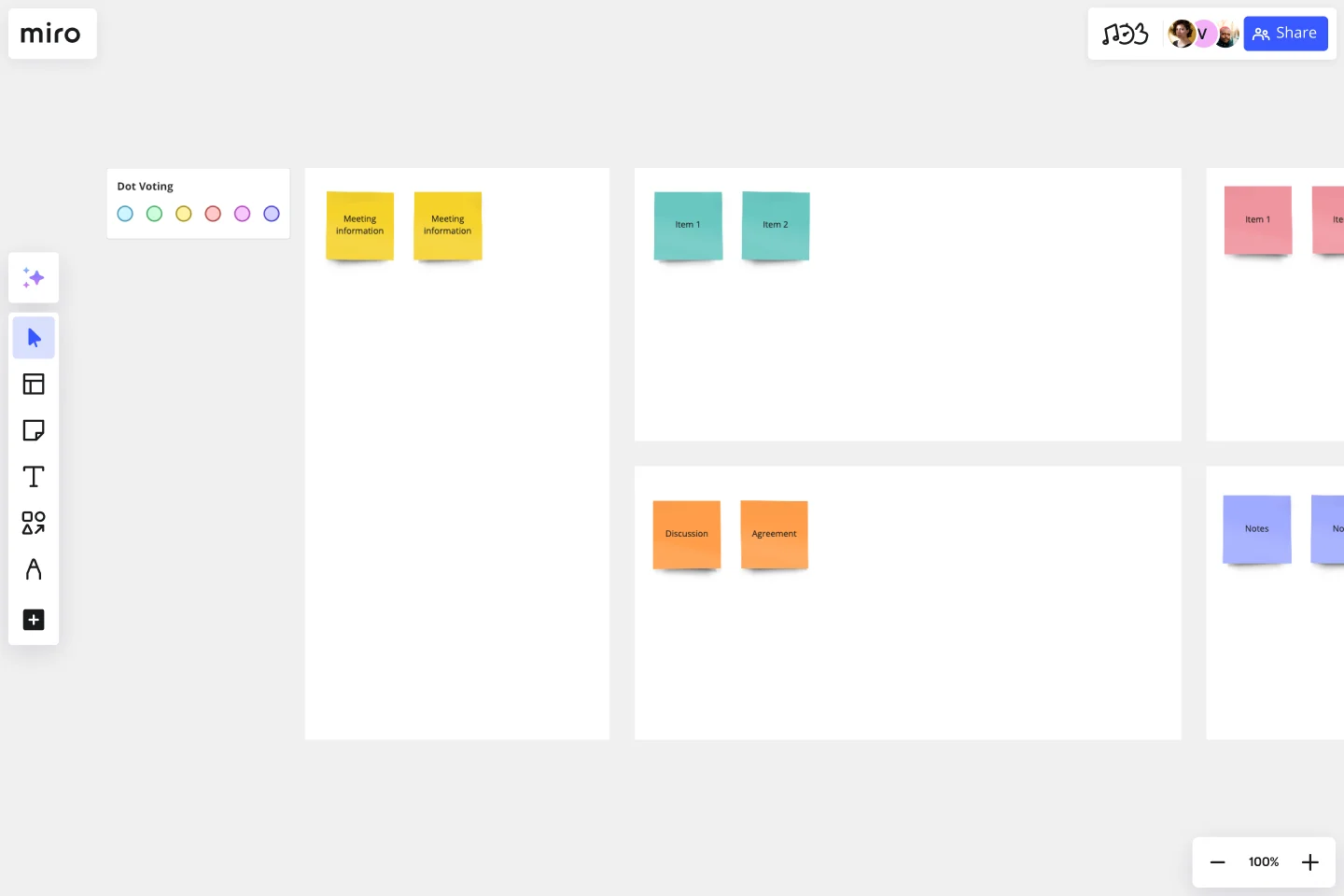Meeting Notes Template
Create a lasting record of what happened during a meeting.
About the Meeting Notes template
If someone asked you how many meetings you have in a given week, you’d probably find it hard to answer -- not because you don’t pay attention, but because you have so many! When you’re in and out of important meetings all day, it can be difficult to remember who said what, or what goals everyone agreed on.
Meeting notes are simply a record of your meeting. Most teams prefer to assign a notetaker at the beginning of each meeting, so one person can focus on capturing the contents of the meeting instead of having everyone scramble to capture what they can. Many teams rotate the notetaker so everyone has an equal stake in the meeting.
Who should use the meeting notes template?
Any team that wants to keep a written record of what happened during a meeting. This is especially important for meetings with action items, deadlines, and decisions. You can assign one person to be responsible or you may want to rotate duties so that a different person is responsible for updating the meeting notes each time.
How to create meeting notes
Step 1: Assign a notetaker before the meeting.
Step 2: Decide on the topics you’re going to cover for the meeting. The notetaker can make a note of these topics.
Step 3: During the meeting, ask the notetaker to summarize the notes from the previous meeting to give you a starting point.
Step 4: Have the notetaker take down the names of the participants, agenda times, action items and due dates, and the main points from the meeting.
Step 5: As the meeting continues, the notetaker can continue to take note of any decisions made by the participants, the most important points covered, and any future decisions that need to be made.
Step 6: The notetaker can share the meeting notes with the team, if appropriate.
How do you use the meeting notes template?
Start with our pre-made template, making any changes you’d like to suit your particular needs. Invite team members to join your board and collaborate. Use the @mention or video chat if you need to get input from others. You can upload other file types such as documents, photos, videos, and PDFs to store all the relevant information in one place.
Get started with this template right now.
Bang for the Buck Template
Works best for:
Project Management, Strategic Planning, Prioritization
The name pretty much says it—this Agile framework is all about helping you maximize efficiency by powering collaboration between product managers and dev teams. Together you can go over each to-do on the project agenda and evaluate them in terms of costs and benefits. That way you can prioritize tasks based on how much bang for your buck they deliver. This template is great for teams and organizations that want to make a strategic plan to tackle an upcoming sprint.
Azure Demand Forecasting Template
Works best for:
Software Development, Diagrams
The Azure Demand Forecasting diagram will show the architecture of a demand forecast, making it easier for you to predict data consumption, costs, and forecast results. Azure is Microsoft’s cloud computing platform, designed to provide cloud-based services such as remote storage, database hosting, and centralized account management. Azure also offers new capabilities like AI and the Internet of Things (IoT).
Idea Funnel Backlog
Works best for:
Design, Brainstorming, Agile Workflows
An Idea Funnel Backlog enables you to visualize your backlog and restrict the number of backlogged items at the top. In doing sos, you can prioritize items on your list without having to engage in unnecessary meetings or create too much operational overhead. To use the Idea Funnel Backlog, break up the funnel into different phases or treat it like a roadmap. Use the Idea Funnel Backlog as a hybrid model that combines your roadmap and backlog into one easily digestible format.
Huddle Board Template
Works best for:
Meetings
The Huddle Board Template is a digital and interactive tool that fosters seamless team collaboration. Mimicking the traditional physical boards used in office environments provides a visual platform where teams can organize tasks, share updates, and track progress. One standout benefit of this template is its real-time collaboration feature. With it, team members can instantly share feedback, change tasks, or raise queries, ensuring everyone is aligned and updated, significantly reducing miscommunication and streamlining project execution.
UML Communication Diagram Template
Works best for:
Software Development, Mapping, Diagrams
Most modern programs consist of many moving parts working to a precise set of instructions. With a communication diagram, you can visualize exactly how those parts work together, giving you a clearer understanding of your program as a whole. What’s more, the diagram leaves spaces for expanding the network of relationships as your product grows and evolves. A communication diagram is a vital tool in any software designer’s arsenal.
Event Planning Template
Works best for:
Planning, Workshops
Whether you’re planning a product launch, fully remote conference, or milestone event, the Event Planning Template will act as a visual checklist and map for all the details you need to consider before the big day. The Event Planning Template is an adaptable way to make sure the creative and strategic vision of your event doesn’t get lost in the details. By mapping out different sections - from the marketing plan, to the agenda, to snacks and swag for guests — you and your team can focus on the details most important to your functions, and collaborate as needed when overlaps occur.
